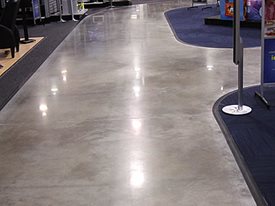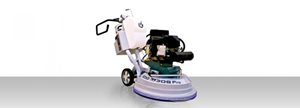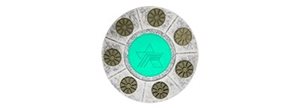Polished Concrete Profiles: How to Achieve Different Levels of Sheen
Time: 03:53
Compare the four classes of aggregate exposure and three levels of gloss outlined by the Concrete Polishing Association of America.

At a level 3 polish, your concrete floors will really begin to shine and clearly reflect side and overhead lighting.
Depending on the diamond grit you use to polish a concrete floor, you can achieve different ranges of aggregate exposure and different levels of sheen, from matte to a glassy mirror-like finish. The Concrete Polishing Council classifies finished gloss levels in ranges from 1 through 4 and aggregate exposures as A, B, C or D, depending on the degree of exposure.
For coarse grinding, you'll generally start out using diamonds embedded in a metal matrix. As you begin to polish the floor in successive passes, you'll typically switch to finer diamond abrasives bonded in a plastic or resinous matrix to achieve higher degrees of shine.
Find concrete polishing contractors near me
Here are the four levels of polishing and the degree of shine you can expect to achieve at each level:
Level 1 (flat)
A level 1 ground polish usually can be obtained by stopping below the100-grit resin bond. When you look directly down at the floor, it will appear somewhat hazy with little if any clarity or reflection.
Level 2 (satin)
A level 2 honed polish is obtained by stopping at the 400-grit resin bond, producing a low-sheen finish. When you look directly down at the finished floor and at a distance of roughly 100 feet, you can start to see a slight overhead reflection. This grit level produces a low-luster matte finish.
Level 3 (semi-polished)
A level 3 polish is achieved by going up to an 800-grit or higher diamond abrasive. The surface will have a much higher sheen than that of level 2 finish, and you'll start to see good light reflectivity. At a distance of 30 to 50 feet, the floor will clearly reflect side and overhead lighting.
Level 4 (highly polished)
This level of polish produces a high degree of shine, so that when standing directly over the surface, you can see your reflection with total clarity. Also, the floor appears to be wet when viewed from different vantage points. A level 4 polish is obtained by going up to a 3,000-grit resin-bond diamond or by burnishing the floor with a high-speed burnisher outfitted with specialty buffing pads.



